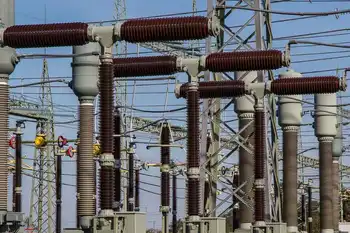Lightning strikes leave a lasting impression
By Toronto Star
NFPA 70b Training - Electrical Maintenance
Our customized live online or in‑person group training can be delivered to your staff at your location.

- Live Online
- 12 hours Instructor-led
- Group Training Available
The sounds she's referring to were apocalyptic – the roar of lightning under her tent. She was camping with her husband, Globe and Mail reporter Les Perreaux, in northern Quebec when a wild storm broke at around 2 a.m. on July 16, she says by phone from Montreal, where the 32-year-old is producer of the local CBC Radio afternoon show.
"You could hear the thunder getting closer, we were counting the time from lightning to thunder, three seconds, two seconds, one second. It sounded like a bomb. An explosion. I felt it was in my head, right there. Our tent is orange and the light coming in was orange, but there was a bright white light and flashes of blue."
Most horribly, they smelled their hair burning, though when they examined themselves later they found no trace of burns. For a moment they were engulfed in the astonishing and mysterious world of lightning, and they survived.
Lightning's power is ferocious. It can blast the core of giant trees and turn bark to shrapnel; each year it starts some 4,000 forest fires in Canada. It blazes through the sky at thousands of kilometres a second. At 28,000 Celsius, lightning is five times hotter than the surface of the sun.
It can truly be a bolt from the blue, striking more than 16 kilometres from a cumulonimbus, known as the king of the clouds.
For that reason, Canada's weather service is considering changing its lightning recommendations, says meteorologist Geoff Coulson of Environment Canada. The current rule is called 30-30. The first 30 refers to taking shelter if there are fewer than 30 seconds between lightning and thunder. It's a way of estimating distance from the storm – each second represents 300 metres. The second is an instruction to wait 30 minutes after the last thunderclap before returning outdoors.
The new guideline is to take cover as soon as you hear thunder. Phrases like "If the sky roars, get indoors" help keep the rule in mind.
The mystery of lightning encompasses not only McNairn's experience – "Why am I alive after this mythical thing?" – but also the science of the phenomenon.
Lightning is produced when positively and negatively charged bits of ice in a thundercloud become separated and are buffeted by air currents, so that the positive charges move to the top of the cloud and the negative, to the bottom. As the cloud moves over a landscape, it causes an increase in the flow of positive charges from the earth.
What's unclear is precisely why lightning strikes in one place and not another. "It sounds like the most fundamental thing – exactly why lightning goes to the ground, why most of it stays in the clouds," says Martin Uman of the University of Florida, where he is director of the Lightning Research Laboratory. "We don't understand the whole initial process."
The problem is that "you can't be in all parts of the cloud at the same time, and clouds change so rapidly," continues Uman, one of the few world experts on lightning and author of The Art and Science of Lightning Protection, published earlier this year. "It's overwhelming."
In his research, Uman is looking for the source of X-rays emitted by lightning. He and a team of engineering researchers reported earlier this month that as lightning descends from the clouds in stages or steps, up to 50 metres long, there's a burst of X-rays just beneath each step. "We're trying to understand why each step should make X-rays, which are associated with (lightning) propagation," he says.
As the negatively charged "step leader" drops toward the Earth's surface, positively charged streamers (which can rise from something tall, like a tree or even a golfer) leap upward to meet it. An electric current occurs when the two connect and a channel of air lights from the bottom up.
"When you have that tingling feeling, when your hair is standing up, there is a flow of positive charges streaming up to meet that negative charge," says David Phillips, Environment Canada's senior climatologist. "It's a sign you're about to be zapped."
Each year in Canada there are 2 to 3 million lightning strikes, which at their most powerful can carry up to 100 million volts of electricity. Lightning is most common in storm-rich southern Ontario between the Great Lakes and in the foothills of the Rockies, but is almost unknown in the Arctic, a situation that may be changing with the advance of global warming. Windsor is the lightning hot spot among major Canadian cities, while Toronto ranks second.
If it seems there's been more lightning this year, that's because there has been, says Phillips. The 34 hours of thunderstorms in Toronto in June and July are more than four times the number last year. (In Hamilton, the increase is six fold.)
About 10 people are killed each year in Canada from lightning; the cause of death is almost always cardiac arrest. A man was killed in a rowboat recently north of Trois-Rivieres, Que., and a 28-year-old man was fatally struck on July 8 while seeking shelter under a solitary maple tree at Christie Pits.
There were many more lightning deaths in the 1930s, when as many as 50 would perish annually. Now people have high-tech weather forecasts and know more about how to protect themselves.
Lightning strikes across Canada may be viewed, almost in real time, on Environment Canada's Lightning Detection Network's website, which is updated hourly. "We can see right down to the millisecond where it is occurring," says William Burrows, a research scientist for Environment Canada in Edmonton. There are 83 electronic detectors, generally in remote parts of the country, that capture lightning strikes and send the information by satellite to a centre in Tucson and then back to Canada's weather centres, where the data is mapped on a computer screen. The process takes about 40 seconds.
Connected to the U.S. national weather service network, the information is used for aviation safety and weather warnings.
Some 125 Canadians a year sustain serious enough injuries when struck by lightning to require hospitalization.
Phillips says about 70 per cent will recover fully, but among the other 30 per cent, some will have profound neurological impairment. Because of frontal lobe damage they may suffer personality changes, lose the ability to process bits of information simultaneously, be slow to react, and/or have poor short-term memory. As a result, they may isolate themselves.
But Phillips contends everyone who's struck is changed – "You're never the same person."
Kim McNairn has been researching weather the past few weeks, trying to understand what happened to her on their camping trip. In a way, her personality has been recalibrated by her encounter with lightning. "People said, 'There is something different about Kim.' Someone told me later I seemed kind of ZenÂ…. They thought something was wrong because I'm a high-energy person...
"To be in the presence of it and survive, it's so thrillingÂ…. It made me focus my life on what's important. I found myself saying I'm really happy to get another chance. What am I going to do with the time I have?"











